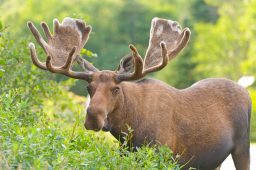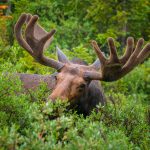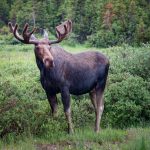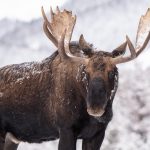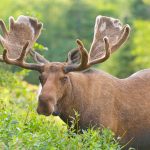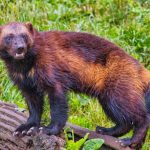European Elk vs North American Moose:
Basically, Its the same animal – For some reason two of the largest deer species alive today got confused – in different places and by different people.
North American Moose vs North American Elk (Wapiti):
(North America and Europe) But the North American Elk the Wapiti on the other hand is a different animal with some clear visual differences.
What Is The Difference Between A Moose And An Elk (And An Elk)?
Well, the difference in appearance is totally obvious for modern humans – but for travelers of the past with little or no experience of international wildlife just chose a name they thought would match – and stuck to it. Even though it was wrong in the end – there was no attempt to change it back – everyone just stuck with what they had.
People from Europe (who had never seen a moose (Alces alces) and assumed it was just a very large deer) came across a very large deer when colonizing the Americas and so assumed it couldn’t possibly be their ‘normal’ red deer (Cervus elaphus) – it had to be an Elk (Alces alces) which was what Europeans called a Moose.
From that moment on, that North American very large deer (Cervus canadensis) became known as an Elk, when in fact it was actually a deer (not a moose). These now called North American ‘elks’ (Cervus canadensis) could be twice as heavy as the Red Deer (Cervus elaphus) they were originally being compared to.
Can you see why the confusion occurred?
The North American Moose: (Alces alces)
The North American Moose is a giant, hairy land mammal with a droopy chin, a giant head, and a set of huge antlers in the males through most of the summer and autumn. They live all across Canada, Alaska, and many northern states and are present all year round. They got their name from the Algonquian languages meaning ‘he strips off’ referring to the moose’s feeding technique – and was eventually adopted by early colonizers.
They have been made famous by many a cartoon character and sports mascot and are always imagined to be rather stupid-looking – even though they are very intelligent creatures. Mainly solitary, they inhabit very cold areas with a certain balance of food and temperature required to survive. If this habitat requirement isn’t met in any one place – they will move on to one that suits better.
The Eurasian Elk: (Alces alces)
The exact same species as the North American Moose. The exact same.
This cohort of the species inhabits the colder regions of Europe and Asia and – just like the North American cohort – has several subspecies living in different areas. They range across a wide area looking for the best feeding and avoiding large predators such as wolves. Hunted to extinction across many parts of Europe, this species had long been missing from the UK before early colonists travelled to America.
The American Elk: Wapiti (Cervus canadensis)
This very large deer belongs to a different family to Alces alces – and have very different antlers to help you tell them apart.
Although they are still huge animals and are sort of the same color – you can tell them apart by a number of features.
Additionally, the Wapiti is related to the Red Deer and Fallow Deer family, but the Moose/Elk is from the group containing the Caribou and White-tailed Deer.
The Wapiti got its name also from the Algonquian languages; meaning ‘white rump’ – a classic patterning on herding deer for warning and signaling to others.
The Wapiti has a much larger range of habitats than the Moose/Elk and can be found as far south as the Mexican border in southwest America and the northern borders of India and Thailand in Asia.
So, What Is The Difference Between A Moose And An Elk?
Well, it depends on which elk you mean – see the two versions detailed below:
1: North American Moose Vs Eurasian Elk:
There is absolutely no difference what-so-ever between a moose and an elk – they are the same species. The version of this animal that lives in Canada and the U.S. is always called a Moose, and the version of this same animal that lives across Europe and northern Asia is always called an Elk.
2: North American Moose Vs North American Elk:
There are quite a few differences between a Moose and a North American Elk (a Wapiti) as one is a giant beast of a mammal with huge palmate antlers (like a plate); a giant head and top lip – and towering at up to 2.1m (6ft 9in) at the shoulder.
The other is only around 1.1m (3.5ft) tall at the shoulder with a very pointy set of branched antlers; a delicate face and an agile body. As its local name suggests – the Wapiti also has a white rump – the Moose does not.

